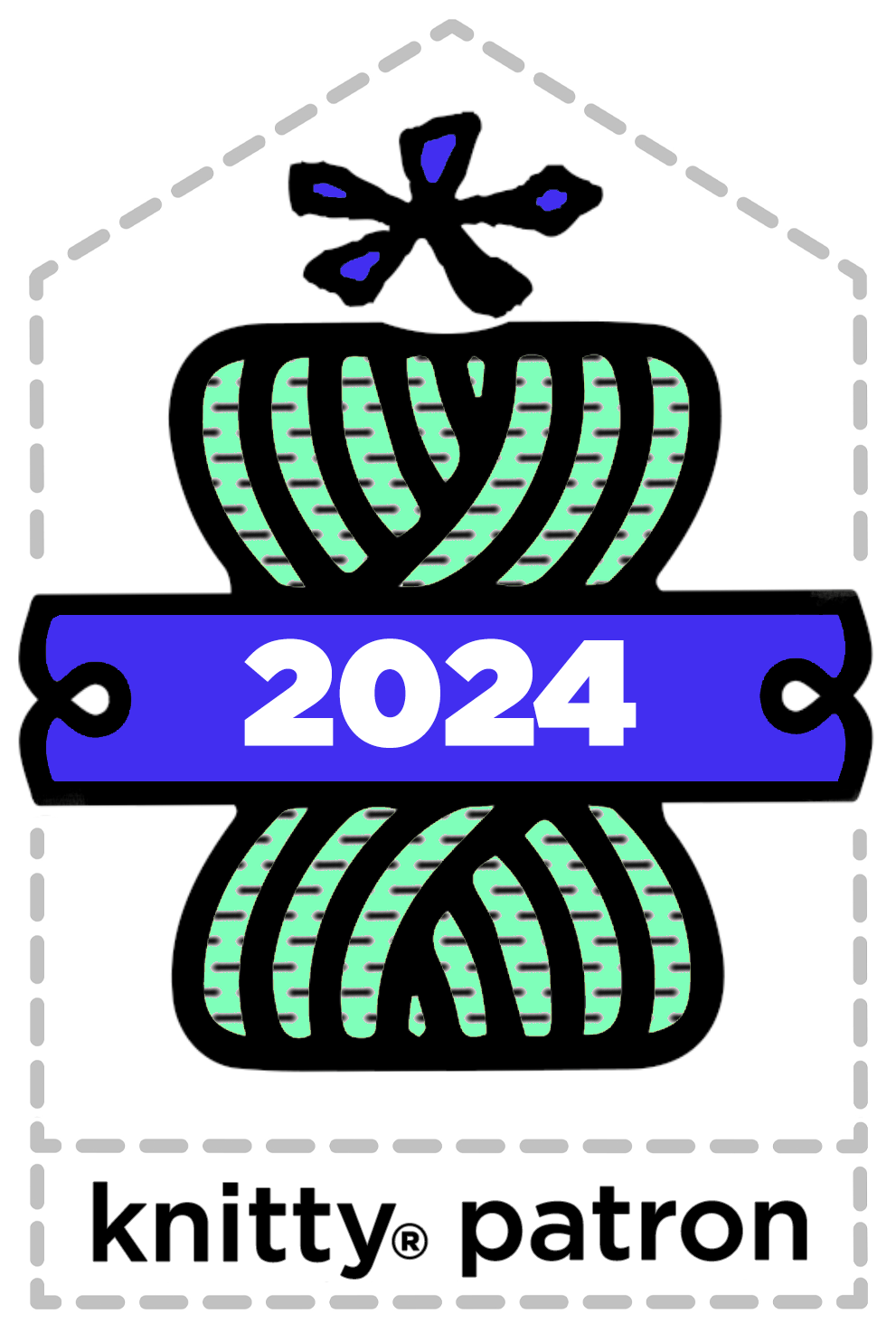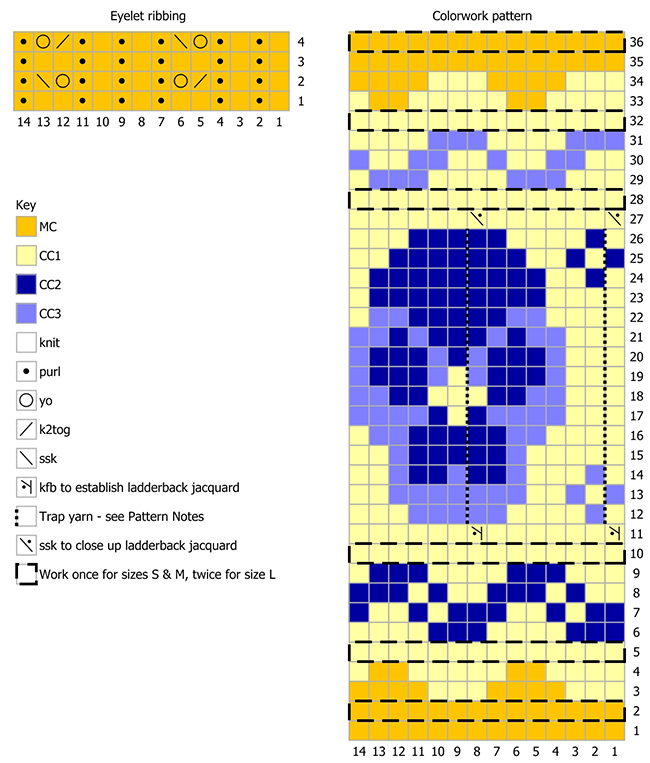Viola Tricolor, a free knitting pattern from Knitty.com.
INTRODUCTION
Viola Tricolor
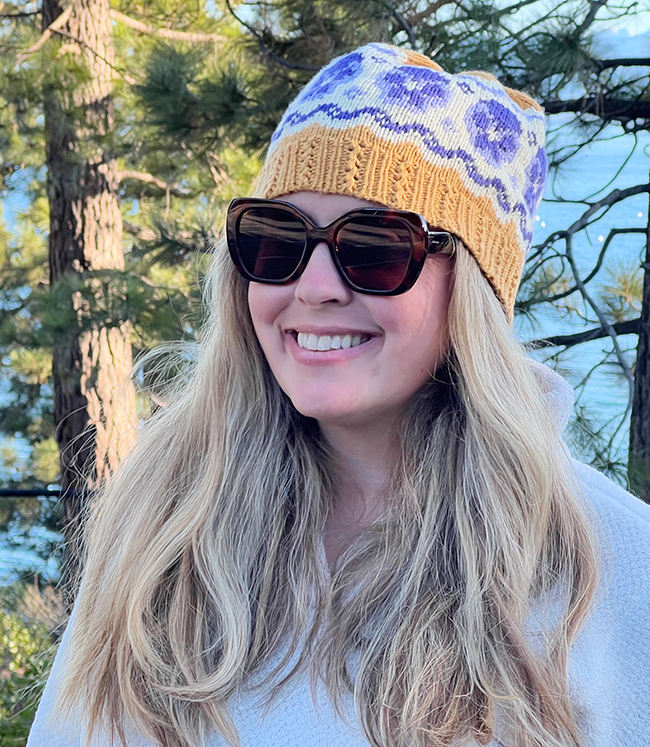 by Kimberly Kalnoki
by Kimberly Kalnoki
![]()
Viola tricolor is the scientific name of the wild pansy, from which modern garden pansies were cultivated. The color palette for this hat was generally inspired by my mother's love of purple flowers of all kinds, and more specifically is based on a violet face icicle pansy. However, since pansies come in a veritable rainbow of shades, a knitter could easily customize the hat with their own favorite colors instead.
This hat depicts a colorwork motif of purple pansies and undulating ribbons against a light yellow background, with a golden brim and crown. The hat begins with a tubular cast-on, followed by 2 inches/5 cm of decorative eyelet ribbing with wavy columns that echo the curved lines of the stranded colorwork. The ribbon motifs are worked with two colors at a time, with short floats that are never long enough to require additional trapping. The pansy motifs feature rounds that require the use of all three contrast colors at the same time, in which the floats are trapped invisibly using the ladderback jacquard technique.
This pattern should be approachable for an adventurous beginner, but also complex enough to keep even the most advanced knitter engaged. The finished hat is a perfect accessory for any time of year that you wish to celebrate flowers with your knitting.
 model: AK
model: AK
 photos: KK
photos: KK
SIZE
Adult S[M, L]
shown in size M
FINISHED MEASUREMENTS
Circumference: 17.25[19.5, 21.5] inches/ 44[49.5, 54.5] cm
Length: 8[8.5, 9.5] inches/ 20[21.5, 24] cm
Choose a size 1-2 inches/2.5-5 cm smaller around than the circumference of your head.
MATERIALS
Yarn
Juniper Moon Farm Cumulus [94% Israeli Mako Cotton, 6% Nylon; 251 yd/230 m per 100g skein];
![]() [MC] Goldenrod; 1 skein
[MC] Goldenrod; 1 skein
![]() [CC1] Clumber Spaniel; 1 skein; approximately 50[60, 75] yds/ 45[55, 70] m
[CC1] Clumber Spaniel; 1 skein; approximately 50[60, 75] yds/ 45[55, 70] m
![]() [CC2] Lavender; 1 skein; approximately 30[35, 45] yds/ 25[30, 40] m
[CC2] Lavender; 1 skein; approximately 30[35, 45] yds/ 25[30, 40] m
![]() [CC3] Lily Lollypop; 1 skein; approximately 30[35, 45] yds/ 25[30, 40] m
[CC3] Lily Lollypop; 1 skein; approximately 30[35, 45] yds/ 25[30, 40] m
Yarn Characteristics
![]() The sample shown uses a light, airy chainette yarn that compresses when worked with smaller than recommended needles. If substituting a different yarn, a bouncy, plied DK-weight yarn would be a good alternative.
The sample shown uses a light, airy chainette yarn that compresses when worked with smaller than recommended needles. If substituting a different yarn, a bouncy, plied DK-weight yarn would be a good alternative.
Recommended needle size
[always use a needle size that gives you the gauge listed below - every knitter's gauge is unique]
![]() US #4/3.5 mm 16 inch/40 cm circular needle
US #4/3.5 mm 16 inch/40 cm circular needle
![]() US #6/4 mm 16 inch/40 cm circular needle
US #6/4 mm 16 inch/40 cm circular needle
![]() US #6/4 mm needles for small circumference in the round (for the crown)
US #6/4 mm needles for small circumference in the round (for the crown)
Notions
![]() stitch marker(s)
stitch marker(s)
![]() yarn needle
yarn needle
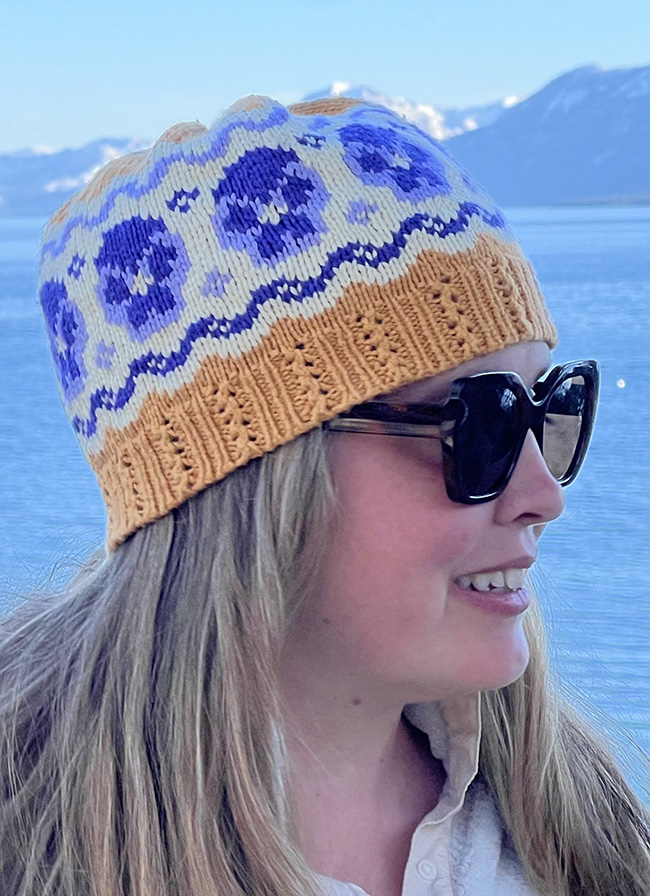
GAUGE
26 sts/36 rounds = 4 inches/10 cm in stranded stockinette stitch using the larger size needle
22 sts/28 rounds = 4 inches/10 cm in single color stockinette stitch using the larger size needle
PATTERN NOTES
[Knitty's list of standard abbreviations and techniques can be found here.]
Casting on
The pattern calls for a tubular cast on, though a different cast on could be substituted. My preferred method for working a tubular cast on is to begin with Judy's Magic Cast On (photo tutorial | video tutorial).
I always cast on over the larger size needles for a tubular cast on to ensure that the edge will be sufficiently stretchy. Then I re-order the stitches into 1×1 ribbing and begin working the brim with the smaller size needles.
There's a tutorial for other methods here.
Size adjustments:
- You can modify the circumference of the hat by increasing or decreasing the cast-on stitch count by a multiple of 12 stitches (to modify the brim and body by a multiple of 14 stitches).
- The length of the brim may be modified by working fewer or more rounds of ribbing as desired.
- The body of the hat may be shortened by removing either or both of the colorwork ribbon motifs.
- The body may be lengthened by adding additional plain stockinette stitch rounds below, between, and/or above the colorwork motifs as needed.
Colorwork
The pattern uses the ladderback jacquard technique to prevent overly-long floats. This method creates hidden columns of purl stitches that invisibly trap the unused color on the wrong side of the fabric (see below).
- Rebecca Diamond colorwork tutorial (video tutorial)
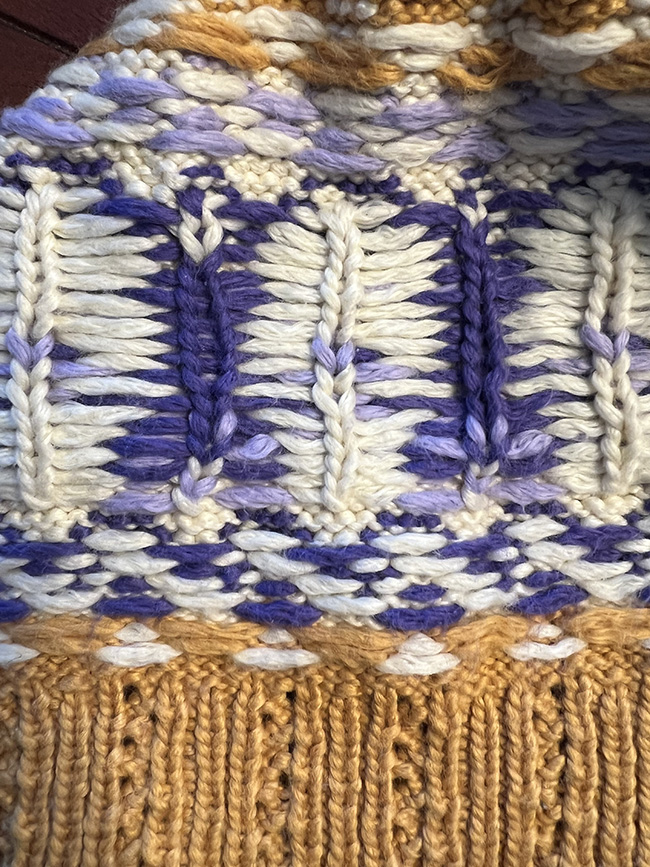
- As shown in the chart, work a kfb increase to create an extra stitch; this stitch is used as a way to trap the color that you are carrying, as follows:
- Hold the working yarns in your preferred arrangement for working stranded colorwork and knit each stitch as indicated by the charted colorwork pattern. When you reach the ladderback jacquard columns, bring both (or all three) of the working yarns to the front of the work, and purl the ladderback jacquard stitch with the least-used color for that segment of the motif. Then return the working yarns to the back of the work and continue knitting the stranded colorwork pattern as charted. The purl stitch will naturally fall to the back of the work. The extra stitch is decreased away once the pansy motifs of the colorwork pattern are complete.
- Always keep the working yarns in back when knitting, and bring both/all of the yarns to the front when purling.
- Rounds 14-22 of the colorwork chart use all three contrast colors in each round. As a continental knitter, I find it helpful to use a yarn guide to assist with managing the working yarns.
- If using a different color palette that changes CC1 from yellow to another color that would not work naturally for the centers of the pansies, you may add yellow stitches over the center stitches after knitting using duplicate stitch.
- Before beginning the crown decreases, the beginning of round is shifted by 2 stitches so that the shaping lines will be centered between each pansy motif.
CHARTS
Eyelet Ribbing
Work from chart or written instructions as you prefer.
Round 1: [(K1, p1) twice, k2, p1)] around.
Round 2: [(K1, p1) twice, k2tog, YO, p1, (k1, p1) twice, YO, SSK, p1] around.
Round 3: Rep Rnd 1.
Round 4: [(K1, p1) twice, YO, SSK, p1, (k1, p1) twice, k2tog, YO, p1] around.
Colorwork pattern:
DIRECTIONS

Brim:
Using a tubular method and smaller circular needle, loosely CO 96[108, 120] sts with MC. Place m and join for working in the round.
Round 1: [(K1, p1) twice, YO, (k1, p1) three times, k1, YO, p1] around. 112[126, 140] sts.
Work Eyelet Ribbing until brim measures 1.5[2, 2.5] inches/ 4[5, 6.5] cm (or desired length), ending after Rnd 2 or Rnd 4.
Final Round: (K3, p1, k2, p1) around.
Colorwork Body:
Switch to larger circular needle.
Body round: Work the 14-stitch Colorwork pattern as charted 8[9, 10] times around.
For size S and M, work Rnds 1-36 as given; for size L, work Rnds 2, 5, 10, 28, 32, and 36 twice each.
Crown:
Setup: Remove m at beg of rnd. K2. Replace m.
Round 1: (K12, k2tog) around. 104[117, 130] sts.
Rounds 2-3: Knit.
Round 4: (K11, k2tog) around. 96[108, 120] sts.
Rounds 5-6: Knit.
Round 7: (K10, k2tog) around. 88[99, 110] sts.
Rounds 8-9: Knit.
Round 10: (K9, k2tog) around. 80[90, 100] sts.
Round 11: Knit.
Round 12: (K8, k2tog) around. 72[81, 90] sts.
Round 13: Knit.
Round 14: (K7, k2tog) around. 64[72, 80] sts.
Round 15: Knit.
Round 16: (K6, k2tog) around. 56[63, 70] sts.
Round 17: (K5, k2tog) around. 48[54, 60] sts.
Round 18: (K4, k2tog) around. 40[45, 50] sts.
Round 19: (K3, k2tog) around. 32[36, 40] sts.
Round 20: (K2, k2tog) around. 24[27, 30] sts.
Round 21: (K1, k2tog) around. 16[18, 20] sts.
Round 22: K2tog around. 8[9, 10] sts.
Break MC yarn, leaving a 6 inch/15 cm tail. Thread tail onto yarn needle and pull through rem sts, cinching tightly to close.
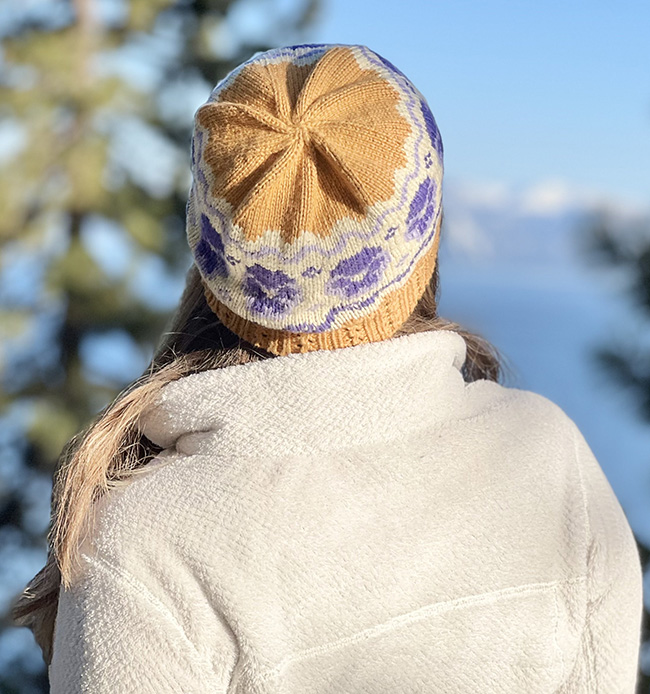
FINISHING
Weave in all ends. Wash according to yarn care instructions, and lay flat to dry. Do not stretch or pin. Once it's dry, you can smooth the colorwork with a bit of light steaming if needed.
ABOUT THE DESIGNER
Kimberly learned to knit from a book as a teenager, then took a hiatus from knitting for about a decade, before returning to it with a passion in her late 20s. As a longtime vegan, she doesn't knit with any animal fibers, which motivated her to begin designing her own patterns.
You can find her on Ravelry.
Pattern & images © 2024 Kimberly Kalnoki







